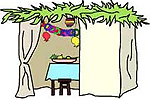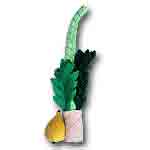|

Sukkot is the first of the Three Pilgrimage Festivals of the Jewish year. Sukkot means “booths” and commemorates the forty-year period during which the children of Israel were wandering in the desert, living in temporary shelters. Sukkot is a seven-day festival beginning 5 days after Yom Kippur. While Yom Kippur was the most solemn day of the Jewish year, in sharp contrast Sukkot is known as the “Season of Our Rejoicing."
Sukkot was instituted in Leviticus 23:33-43 and, like the other Pilgrimage Festivals, also has an agricultural component. The holiday celebrates the autumn harvest. Decorations for the festival focus on this theme and feature fall items.
|
|
THE SUKKAH
  
The dominate activity of Sukkot is the building of a sukkah or temporary dwelling. The sukkah is constructed before the holiday commences. Once the holiday begins we are commanded to dwell in the sukkah at a minimum by taking all one’s meals there. It is preferable to spend as much time as possible in the sukkah using it for family praying, singing, conversing, hosting guests, and sleeping.
The sukkah must have at least three full walls constructed in a way to not blow away. The roof is meant to give shade, but not be solid. It must be made of cut vegetative material that are left loose and set sparsely enough to let rain in and ideally to see the night stars. While the sukkah can be any size, it must be large enough for the entire family and guests to comfortably sit.
The sukkah is meant to host all the week's activities. One of the best aspects of Sukkot is the spirit of community it creates. It is a time to visit with friend in their sukkah and for others to visit yours. Guest come to converse, to eat, to laugh, to sing and sometimes just to sit. Children in the neighborhood go from sukkah to sukkah to sing and dance for the inhabitants. It really is a joyous occasion.
|
|
SPIRITUALITY OF THE SUKKAH
  
Beyond the fun of the sukkah, there is also deep spirituality to be found there. When we enter the sukkah we leave the protective environment of our permanent homes. In the sukkah we are in a less secure physical environment, but there we purely bask in the protection of God’s presence.
It is a tradition that while we are accepting our earthly guests that we meditate on the presence of seven divine guests. These seven very special guests are Abraham, Isaac, Jacob, Moses, Aaron, Joseph and David. Collectively these visitors are known as Ushpizin, the Aramaic word meaning "guests."
There is a reason these specific seven personalities visit our sukkah. In each of their lifetimes they literally did what the sukkah represents – left the security of home for something far less secure, trusting God to be their protector.
The Ushpizin come to us as “visitors” to teach us about seven different divine attributes which serve as spiritual pathways. Each of the seven nights of Sukkot these transcendent visitors arrive, all seven are present, but each takes his turn to lead the other six. Each leader brings his own lesson and message for our devotion and contemplation.
We are to meditate on these divine attributes and then use them to guide our behavior in the coming year. When we manifest them in our daily lives the light of God shines down on the world.
Even if you don’t have a sukkah this year you can spend this week with the Ushpizin, contemplating their ways of life, the attributes they represent and how they can enhance our lives.
May the inspiration of the Ushpizin guests help us to fulfill the potential of Sukkot – to enjoy, uplift and rejoice in our connection to our community, God and the greater world around us!
|
|
The JesusBoat.com website is available throughout the holiday for orders.
The JesusBoat.com offices are closed for Sukkot 09 October to 12 October, 2014
|
|
|
|
The Four Species
Another activity in the sukkah is shaking the Four Species, called Arba Minim in Hebrew.
Within the commandment that mandates Sukkot is the instruction to bring together four plants and “rejoice before the Lord.”
The Four Species are the lulav (palm frond), the hadas (myrtle branch), arava (willow branch) and etog (citron).
The first three are bound together and held in the right hand and the etog is separate and held in the left. Bringing them together they are shaken in six directions – north, south, east, west, above and below – while reciting a blessing.
There are different interpretations regarding the symbolism of the arba minim. One prominent explanation is each plant represents a different body part.
By binding them together and moving them collectively in all directions shows one’s entire being in service to God in every aspect of life.
Lulav – the spine
Hadass – the eye
Aravah – the mouth
Etrog – the heart
Below : Plush Four Species available at JesusBoat.com
|
|
The 7 Ushpizin
and
Divine Attributes
1st day: Abraham
love, benevolence
2nd day: Isaac
restraint,discipline
3rd day: Jacob
beauty, truth
4th day: Moses
endurance,
knowing The Word
5th day: Aaron
compassion,
divine splendor
6th day: Joseph
spiritual foundation and connection
7th day: David
the establishment of the Kingdom of Heaven
|
|
|






